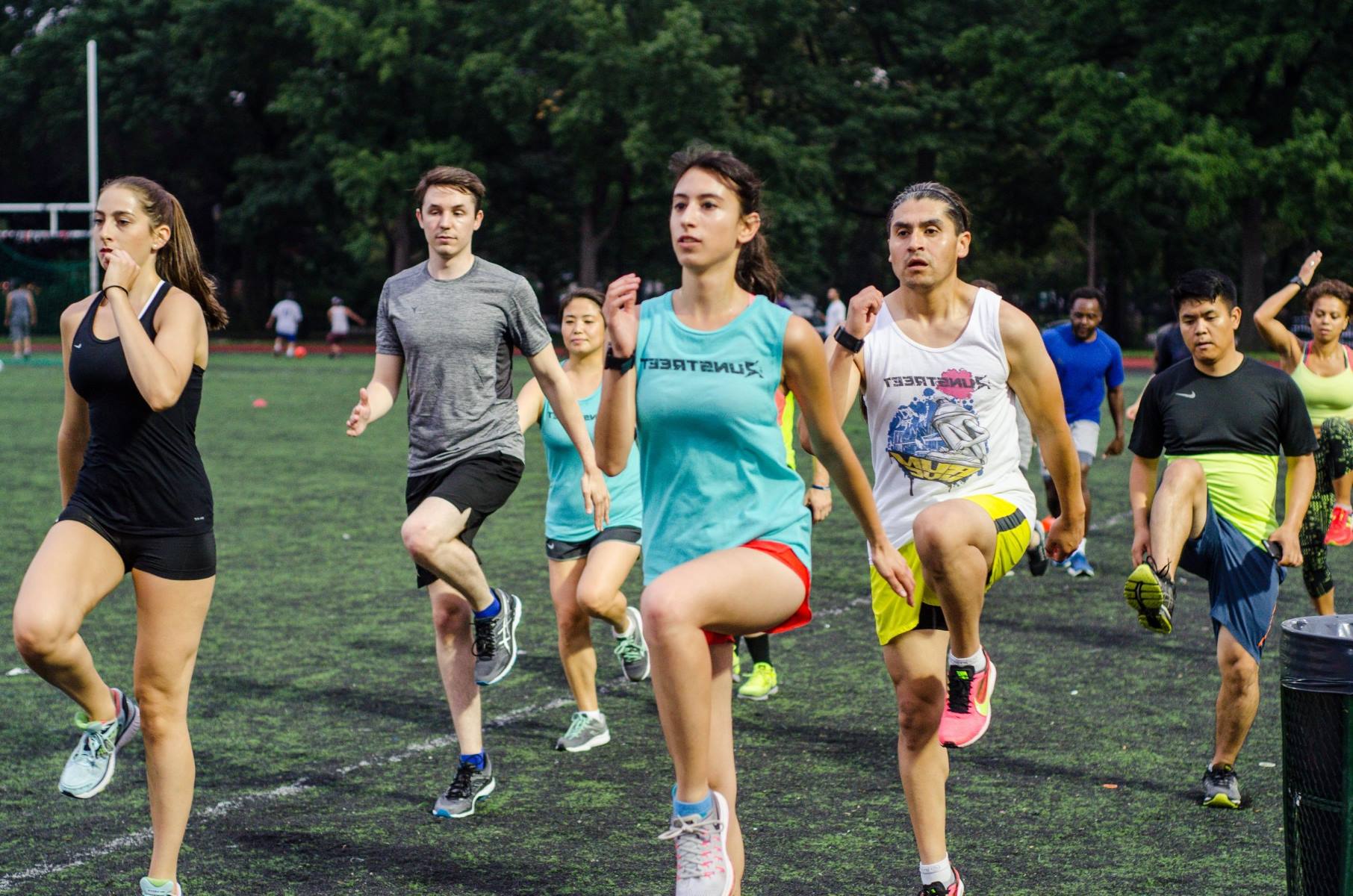Home>Training & Techniques>Beginner's Guide>Top 10 Running Tips: Expert Advice Blog For Runners


Beginner's Guide
Top 10 Running Tips: Expert Advice Blog For Runners
Published: February 9, 2024
Discover top 10 running tips and expert advice for beginners in our blog. Get the best beginner's guide to start your running journey today!
(Many of the links in this article redirect to a specific reviewed product. Your purchase of these products through affiliate links helps to generate commission for Therunningadvisor.com, at no extra cost. Learn more)
Table of Contents
Introduction
Running is a fantastic way to stay fit, clear your mind, and enjoy the great outdoors. Whether you're a seasoned runner or just starting out, there's always room for improvement and new insights to enhance your running experience. In this expert advice blog, we'll explore the top 10 running tips to help you maximize your performance, prevent injuries, and make the most of every run.
As a beginner, it's crucial to build a strong foundation of knowledge and techniques to ensure a safe and enjoyable running journey. For experienced runners, refining your approach and learning new strategies can take your running to the next level. No matter where you are in your running journey, these expert tips will provide valuable guidance and inspiration to help you achieve your running goals.
From proper footwear and warm-up techniques to hydration, nutrition, and mental preparation, each tip is designed to address key aspects of running that can significantly impact your performance and overall experience. By incorporating these tips into your routine, you'll not only improve your running abilities but also foster a deeper connection with the sport.
So, lace up your running shoes, get ready to hit the pavement, and let's dive into these expert tips that will elevate your running game and empower you to conquer new milestones. Whether you're aiming to complete your first 5K, conquer a marathon, or simply enjoy the physical and mental benefits of running, these tips will serve as your trusted companions on the exhilarating journey ahead.
Tip 1: Proper Footwear
Choosing the right footwear is a crucial foundation for every runner. The shoes you wear can significantly impact your comfort, performance, and overall running experience. When it comes to selecting the perfect pair of running shoes, several key factors should be considered to ensure optimal support and protection for your feet.
First and foremost, it's essential to understand your foot type and running gait. Different individuals have varying arch types – high, normal, or low – which can influence the type of support and cushioning needed in a running shoe. Additionally, analyzing your running gait, whether you overpronate, underpronate, or have a neutral gait, is essential in determining the right level of stability and cushioning required to minimize the risk of injury.
Furthermore, the terrain on which you primarily run should also influence your choice of footwear. For road running, shoes with ample cushioning and lightweight construction are ideal for absorbing impact and promoting agility. On the other hand, trail running demands shoes with enhanced traction, durable outsoles, and protective features to navigate uneven terrain and obstacles effectively.
Additionally, the fit of the shoe is paramount. It's recommended to have a thumb's width of space between the tip of your longest toe and the end of the shoe to allow for natural foot swelling during a run. Ensuring a snug yet comfortable fit around the heel and midfoot is also crucial to prevent slippage and discomfort.
Moreover, regularly replacing your running shoes is essential to maintain optimal support and cushioning. As a general guideline, running shoes should be replaced every 300-500 miles, depending on factors such as your running style, body weight, and the terrain on which you run.
By investing in high-quality, properly fitting running shoes that cater to your specific foot type, gait, and running environment, you can minimize the risk of discomfort, pain, and potential injuries. Ultimately, proper footwear not only enhances your running performance but also nurtures the health and well-being of your feet, allowing you to fully embrace the joy and benefits of running.
Tip 2: Warm Up and Cool Down
Proper warm-up and cool-down routines are essential components of a well-rounded running regimen. These practices not only prepare your body for the physical demands of running but also aid in recovery and injury prevention. By incorporating effective warm-up and cool-down strategies into your routine, you can optimize your performance, minimize the risk of muscle strain, and promote overall well-being.
Warm-Up:
Before embarking on a run, dedicating time to a dynamic warm-up routine can significantly benefit your body and running experience. A dynamic warm-up involves engaging in active movements that gradually increase your heart rate, stimulate blood flow to the muscles, and enhance flexibility. This prepares your body for the upcoming physical exertion and reduces the likelihood of injury.
Dynamic warm-up exercises may include leg swings, high knees, butt kicks, arm circles, and lunges. These movements help loosen tight muscles, improve joint mobility, and mentally prepare you for the run ahead. Additionally, incorporating light jogging or brisk walking into your warm-up routine can further elevate your heart rate and prime your cardiovascular system for the impending workout.
Cool-Down:
After completing a run, the cool-down phase is equally important for aiding muscle recovery and promoting flexibility. Cool-down exercises help gradually lower your heart rate, prevent blood pooling in the extremities, and facilitate the removal of metabolic by-products from the muscles. This phase also provides an opportunity to stretch and relax the muscles, reducing post-run stiffness and soreness.
Incorporating static stretches targeting major muscle groups, such as the quadriceps, hamstrings, calves, and hip flexors, can effectively alleviate muscle tension and enhance flexibility. Holding each stretch for 15-30 seconds allows the muscles to relax and elongate, contributing to improved overall mobility and reduced risk of injury.
Moreover, engaging in foam rolling during the cool-down phase can further aid in muscle recovery by targeting specific areas of tightness and promoting blood circulation. Foam rolling helps release muscle knots and adhesions, providing relief from post-run muscle tightness and discomfort.
By embracing the practice of thorough warm-up and cool-down routines, you can optimize your running performance, mitigate the risk of injury, and foster a deeper connection with your body. These essential pre- and post-run rituals not only contribute to physical well-being but also enhance the overall enjoyment and sustainability of your running journey.
Read more: Expert Advice On Splayed Feet And Running
Tip 3: Hydration and Nutrition
Maintaining optimal hydration and nutrition is paramount for runners to sustain energy levels, support muscle function, and facilitate overall performance. The fusion of proper hydration and balanced nutrition forms the cornerstone of a successful running regimen, enabling runners to conquer their goals while safeguarding their well-being.
Hydration:
Hydration plays a pivotal role in regulating body temperature, lubricating joints, and transporting nutrients to cells, making it indispensable for runners. Adequate fluid intake before, during, and after runs is essential to prevent dehydration, which can lead to decreased performance, muscle cramps, and fatigue.
Before a run, it's advisable to consume approximately 16-20 ounces of water 1-2 hours prior to the workout to ensure proper hydration. During longer runs, especially in warm conditions, replenishing fluids at regular intervals is crucial to offset the loss of sweat and maintain optimal hydration levels. Electrolyte-enhanced drinks can also be beneficial for replenishing sodium and potassium lost through sweating, thereby supporting muscle function and preventing cramping.
Post-run hydration is equally vital for replenishing fluid losses and kickstarting the recovery process. Consuming water or a sports drink within 30 minutes of completing a run can aid in rehydration and promote muscle recovery, setting the stage for optimal post-run nutrition.
Nutrition:
Fueling your body with the right nutrients is essential for sustaining energy levels, promoting muscle repair, and optimizing recovery. A well-rounded diet that encompasses a balance of carbohydrates, protein, healthy fats, vitamins, and minerals is instrumental in supporting the demands of running.
Carbohydrates serve as the primary fuel source for running, providing the energy needed to sustain endurance and performance. Incorporating complex carbohydrates such as whole grains, fruits, and vegetables into your diet can supply a steady release of energy, enhancing your running capabilities.
Protein is vital for muscle repair and growth, making it crucial for runners to support recovery and maintain muscle integrity. Lean sources of protein, including poultry, fish, legumes, and dairy products, contribute to the repair of muscle tissue and aid in the adaptation to training stress.
Furthermore, integrating healthy fats, such as avocados, nuts, and olive oil, into your diet can provide sustained energy and support overall health. Essential vitamins and minerals, including iron, calcium, and vitamin D, play key roles in maintaining bone health, muscle function, and overall well-being, making them essential components of a runner's diet.
By prioritizing proper hydration and nutrition, runners can optimize their performance, enhance recovery, and fortify their bodies against the physical demands of running. These foundational elements not only fuel the body but also nurture a holistic approach to running, empowering individuals to thrive and excel in their running pursuits.
Tip 4: Setting Realistic Goals
Setting realistic and achievable goals is a fundamental aspect of a successful running journey. Whether you're a novice runner or a seasoned athlete, establishing clear and attainable objectives can provide direction, motivation, and a sense of accomplishment. Realistic goal setting involves a thoughtful and strategic approach that aligns with your current fitness level, lifestyle, and aspirations, ultimately paving the way for sustained progress and fulfillment.
When setting running goals, it's essential to consider both short-term and long-term objectives. Short-term goals, such as completing a specific distance or improving your pace over a set period, offer immediate targets to strive for, fostering a sense of accomplishment and momentum. Long-term goals, such as participating in a marathon or achieving a personal best in a race, provide a broader vision that fuels dedication and perseverance over an extended timeline.
Moreover, the process of setting realistic goals involves a thorough assessment of your current abilities and circumstances. By acknowledging your starting point and understanding your strengths and areas for improvement, you can establish goals that are challenging yet within reach. This approach helps prevent undue pressure and frustration while promoting a positive and sustainable running experience.
Additionally, setting specific and measurable goals enhances clarity and accountability. Instead of vague aspirations, such as "improve my running," articulating precise objectives, such as "complete a 10K race in under 50 minutes," provides a clear target to work towards. Measurable goals enable you to track progress, celebrate milestones, and adjust your approach as needed, fostering a sense of purpose and achievement throughout your running journey.
Furthermore, it's crucial to factor in external variables, such as work commitments, family responsibilities, and potential obstacles, when setting running goals. By aligning your goals with your lifestyle and considering potential challenges, you can create a realistic framework that accommodates your daily routine and minimizes unnecessary strain.
Ultimately, setting realistic goals empowers runners to embrace a balanced and sustainable approach to their training. By cultivating a mindset focused on achievable milestones and continuous improvement, individuals can derive fulfillment from their running pursuits while fostering a sense of resilience and determination. Embracing the journey of goal pursuit, with its inherent challenges and triumphs, enriches the running experience and propels individuals towards lasting success and personal growth.
Read more: Expert Advice For Running In Hot Weather
Tip 5: Cross-Training
Cross-training serves as a dynamic and multifaceted approach to enhancing overall fitness and performance for runners. This strategic training method involves incorporating a diverse range of complementary exercises and activities into your workout regimen, providing a holistic approach to physical conditioning and skill development.
One of the primary benefits of cross-training for runners is the opportunity to target different muscle groups and movement patterns that may not be fully engaged during running alone. By diversifying your training routine to include activities such as cycling, swimming, yoga, strength training, or Pilates, you can address muscular imbalances, improve overall strength, and reduce the risk of overuse injuries. Engaging in activities that challenge different muscle groups and movement patterns can contribute to enhanced muscular endurance, stability, and agility, ultimately bolstering your running performance.
Furthermore, cross-training offers a valuable avenue for active recovery and injury prevention. By incorporating low-impact activities, such as swimming or cycling, on designated recovery days, you can promote circulation, alleviate muscle soreness, and facilitate the repair and regeneration of tissues. This strategic approach to recovery not only supports physical well-being but also fosters mental rejuvenation, allowing you to approach your next run with renewed energy and vitality.
In addition to physical benefits, cross-training can also serve as a source of mental refreshment and motivation. Breaking away from the repetitive nature of running and engaging in alternative activities can reignite your enthusiasm for training, prevent burnout, and stimulate mental acuity. Whether it's a yoga session to enhance flexibility and mindfulness or a strength training workout to build functional strength, cross-training introduces variety and excitement into your fitness routine, nurturing a well-rounded and sustainable approach to training.
Moreover, cross-training provides an avenue for addressing weaknesses and honing specific skills that directly contribute to running performance. For instance, incorporating strength training exercises targeting the core, hips, and lower body can enhance running biomechanics, stability, and power transfer, leading to improved running economy and efficiency. Similarly, activities such as swimming can enhance cardiovascular endurance and breath control, complementing the cardiovascular demands of running.
By integrating cross-training into your running regimen, you can cultivate a comprehensive and resilient foundation that extends beyond the confines of running itself. This multifaceted approach not only enhances physical capabilities but also fosters a sense of versatility, adaptability, and overall well-being, empowering you to thrive as a well-rounded and resilient runner. Embracing the diversity and enrichment that cross-training offers can elevate your running journey, instilling a sense of vitality, longevity, and fulfillment in your pursuit of running excellence.
Tip 6: Listening to Your Body
Listening to your body is a fundamental principle that underpins a harmonious and sustainable running journey. It involves developing a keen awareness of the signals and cues your body communicates, allowing you to make informed decisions that promote well-being, prevent injury, and optimize performance. This mindful approach to running transcends mere physical exertion, encompassing a holistic understanding of your body's needs, limitations, and potential.
Central to the practice of listening to your body is the cultivation of bodily awareness. This entails tuning into the subtle feedback your body provides during runs, encompassing sensations such as muscle fatigue, joint discomfort, breathing patterns, and overall energy levels. By attuning yourself to these internal cues, you can make real-time adjustments to your running pace, intensity, and form, ensuring that you honor your body's signals and avoid pushing beyond sustainable limits.
Furthermore, listening to your body involves differentiating between discomfort that arises from exertion and pain that signals potential injury. Understanding the nuanced distinction between normal exertion-related sensations and indicators of potential harm is crucial for safeguarding your physical well-being. By acknowledging and responding to warning signs such as sharp or persistent pain, unusual joint instability, or pronounced fatigue, you can take proactive measures to address underlying issues and prevent the escalation of injuries.
Incorporating periods of active recovery and rest into your training schedule is an integral aspect of heeding your body's cues. Embracing rest days and incorporating lighter training sessions allows your body to recuperate, adapt to training stress, and regenerate tissues, fostering resilience and longevity in your running pursuits. By recognizing the importance of rest and recovery, you can mitigate the risk of overtraining, burnout, and chronic fatigue, ultimately promoting sustained progress and well-being.
Moreover, listening to your body extends beyond the physical realm, encompassing mental and emotional aspects as well. Being attuned to your mental state, stress levels, and emotional well-being enables you to approach running with a balanced and mindful mindset. Acknowledging the impact of external stressors and emotional fluctuations on your running performance empowers you to cultivate a holistic approach to self-care, resilience, and mental fortitude.
In essence, listening to your body is a profound practice that transcends the mechanical act of running, embodying a deep respect for the intricate interplay of physical, mental, and emotional facets. By embracing this mindful approach, you can forge a sustainable and enriching relationship with running, fostering a profound sense of self-awareness, resilience, and empowerment in your pursuit of running excellence.
Tip 7: Proper Form and Technique
Proper form and technique are foundational pillars that significantly influence a runner's performance, efficiency, and injury prevention. Cultivating a mindful and intentional approach to running mechanics can yield profound benefits, enhancing running economy, reducing the risk of overuse injuries, and optimizing overall running prowess.
Central to proper form is the alignment of the body, encompassing posture, stride, and foot strike. Maintaining an upright posture with a slight forward lean from the ankles promotes optimal spinal alignment, allowing for efficient energy transfer and minimizing undue stress on the lower back. Engaging the core muscles to stabilize the torso further supports posture, fostering a balanced and controlled running gait.
Striking a harmonious balance between stride length and cadence is pivotal for optimizing running efficiency and minimizing impact forces. Striving for a moderate stride length and a cadence of around 170-180 steps per minute can promote a smooth and fluid running motion, reducing the risk of overstriding and excessive braking forces. This balanced approach to stride and cadence facilitates a more energy-conserving and sustainable running technique.
Furthermore, the manner in which the foot makes contact with the ground, known as foot strike, plays a crucial role in running mechanics. While individual variations exist, aiming for a midfoot or forefoot strike pattern can distribute impact forces more evenly throughout the lower extremities, potentially reducing the risk of certain overuse injuries associated with heel striking.
In addition to body alignment and foot strike, arm swing and overall upper body mechanics contribute to running efficiency and stability. Maintaining relaxed and fluid arm movements that complement the natural rhythm of the legs can enhance balance and propulsion. Minimizing excessive arm swing and tension in the upper body conserves energy and promotes a more streamlined running form.
Moreover, integrating drills and exercises that target running form, such as strides, hill sprints, and dynamic mobility drills, can enhance neuromuscular coordination, proprioception, and overall running mechanics. These targeted interventions not only refine running technique but also cultivate a heightened sense of body awareness and control, empowering runners to optimize their movement patterns.
By prioritizing proper form and technique, runners can unlock their full potential, fostering a harmonious and sustainable relationship with running. Embracing the nuances of running mechanics and investing in their refinement can lead to enhanced performance, resilience, and longevity in the pursuit of running excellence.
Tip 8: Rest and Recovery
Rest and recovery are indispensable components of a well-rounded running regimen, playing a pivotal role in sustaining physical well-being, optimizing performance, and fostering long-term running success. Embracing the restorative power of adequate rest and strategic recovery practices is essential for runners to mitigate the cumulative effects of training stress, prevent overuse injuries, and promote overall vitality.
Rest days, interspersed strategically throughout the training schedule, provide a crucial opportunity for the body to repair and adapt to the physiological demands of running. By allowing for periods of active recovery and complete rest, runners can replenish glycogen stores, repair muscle tissue, and regulate systemic inflammation, setting the stage for enhanced resilience and performance. Moreover, rest days serve as a mental reprieve, offering a chance to recharge, recalibrate motivation, and cultivate a balanced approach to training.
In addition to scheduled rest days, incorporating adequate sleep into your routine is fundamental for optimizing recovery and overall well-being. Quality sleep plays a pivotal role in hormone regulation, immune function, and tissue repair, all of which are essential for the body's adaptation to training stress. Prioritizing consistent and restorative sleep patterns supports the body's natural recovery processes, fostering physical and mental rejuvenation that directly translates to improved running performance.
Strategic recovery practices, such as foam rolling, massage therapy, and contrast water therapy, can further enhance the body's capacity to recuperate from the demands of running. Foam rolling aids in releasing muscle tension and promoting blood circulation, while massage therapy can alleviate muscle soreness and enhance tissue recovery. Contrast water therapy, involving alternating periods of immersion in hot and cold water, can facilitate enhanced circulation and reduce post-run inflammation, contributing to expedited recovery.
Moreover, embracing active recovery strategies, such as gentle yoga sessions, leisurely walks, or low-impact cross-training activities, can promote circulation, alleviate muscle tightness, and foster mental relaxation. These activities not only support physical recovery but also contribute to a holistic approach to well-being, nurturing a balanced and sustainable relationship with running.
By honoring the rest and recovery phases as integral components of your running journey, you can cultivate a resilient and thriving approach to training. Embracing the restorative power of rest, sleep, and targeted recovery practices empowers runners to sustainably progress, minimize the risk of burnout, and derive enduring fulfillment from their running pursuits. In essence, rest and recovery serve as the cornerstone of a vibrant and enduring running experience, fostering a harmonious balance between exertion and rejuvenation.
Tip 9: Mental Preparation
Mental preparation stands as a cornerstone of running excellence, encompassing the cultivation of a resilient and focused mindset that empowers runners to conquer challenges, sustain motivation, and thrive in their pursuit of running goals. The profound interplay between mental fortitude and running performance underscores the significance of nurturing a resilient and adaptive mindset that transcends the physical demands of the sport.
Central to mental preparation is the cultivation of a positive and resilient mindset that embraces challenges as opportunities for growth and self-discovery. Embracing a growth-oriented perspective allows runners to approach setbacks, obstacles, and moments of discomfort as integral components of their journey, fostering a sense of resilience and determination. By reframing challenges as catalysts for personal and athletic development, runners can harness adversity as a source of strength and empowerment, propelling them towards enduring success.
Moreover, mental preparation involves the cultivation of mindfulness and present-moment awareness during runs. By anchoring their focus on the present, runners can navigate the physical and mental demands of running with heightened clarity and intention. Embracing mindfulness allows individuals to attune themselves to the rhythm of their breath, the sensation of their footsteps, and the beauty of their surroundings, fostering a profound sense of connection and immersion in the running experience.
Additionally, visualization and mental rehearsal serve as powerful tools for mental preparation, enabling runners to mentally simulate successful race scenarios, overcome performance anxiety, and reinforce a sense of confidence and readiness. Engaging in visualization exercises that vividly depict achieving running milestones, surmounting challenges, and embodying peak performance can instill a deep sense of belief and conviction, empowering runners to actualize their aspirations with unwavering determination.
Furthermore, the practice of setting and affirming positive affirmations and mantras can fortify mental resilience and foster a sense of empowerment. Affirmations that resonate with personal values, strengths, and aspirations can serve as anchors of motivation and resolve, providing a source of inspiration and encouragement during challenging moments. By internalizing and embodying affirmations that align with their running journey, individuals can cultivate a steadfast and empowered mindset that transcends adversity and propels them towards enduring success.
In essence, mental preparation serves as a profound and transformative dimension of the running experience, nurturing a resilient and empowered mindset that transcends physical exertion and propels individuals towards enduring success. By embracing the principles of mental fortitude, mindfulness, visualization, and positive affirmation, runners can cultivate a profound sense of self-mastery and resilience, fostering a harmonious and enduring relationship with running.
Tip 10: Consistency and Patience
Consistency and patience stand as the bedrock of a successful and enduring running journey, embodying the steadfast commitment and unwavering resolve that underpin sustained progress and achievement. The fusion of consistency and patience transcends mere adherence to a training schedule; it encapsulates a profound and enduring mindset that empowers runners to navigate the peaks and valleys of their journey with resilience, fortitude, and unwavering dedication.
Consistency, marked by the unwavering commitment to regular training and incremental progress, forms the cornerstone of running excellence. Embracing a consistent training regimen fosters the development of physical adaptations, endurance, and skill refinement, laying the groundwork for sustained improvement and resilience. By honoring the rhythm of consistent training, runners cultivate a sense of discipline, routine, and dedication that propels them towards enduring success, one step at a time.
Patience, the art of embracing the journey with equanimity and fortitude, complements consistency by fostering a balanced and sustainable approach to progress. Patience empowers runners to honor the incremental nature of improvement, acknowledging that enduring success is a culmination of persistent effort, resilience, and adaptability. By embracing patience, runners navigate setbacks, plateaus, and challenges with grace and determination, fostering a profound sense of self-mastery and fortitude.
The interplay between consistency and patience extends beyond the physical realm, encompassing mental and emotional dimensions as well. Consistency nurtures mental resilience, fortitude, and unwavering determination, empowering runners to navigate the ebb and flow of motivation and dedication with steadfast resolve. Patience, on the other hand, fosters emotional equilibrium, adaptability, and a profound sense of self-awareness, enabling runners to approach their journey with grace, resilience, and enduring fulfillment.
In essence, the fusion of consistency and patience embodies a profound and transformative approach to running, one that transcends the confines of physical exertion and propels individuals towards enduring success. By embracing the principles of consistency and patience, runners cultivate a resilient and empowered mindset that honors the incremental nature of progress, fosters a profound sense of self-mastery, and propels them towards enduring success in their pursuit of running excellence.













